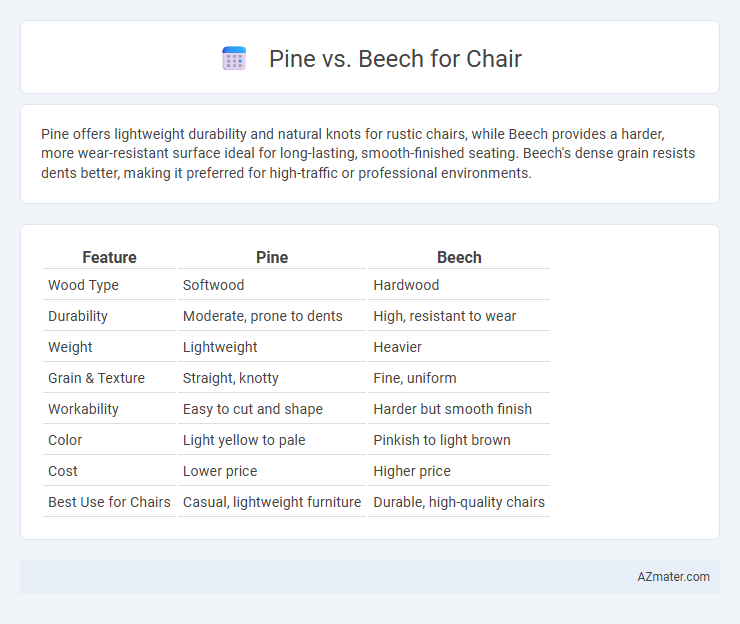Pine offers lightweight durability and natural knots for rustic chairs, while Beech provides a harder, more wear-resistant surface ideal for long-lasting, smooth-finished seating. Beech's dense grain resists dents better, making it preferred for high-traffic or professional environments.
Table of Comparison
| Feature | Pine | Beech |
|---|---|---|
| Wood Type | Softwood | Hardwood |
| Durability | Moderate, prone to dents | High, resistant to wear |
| Weight | Lightweight | Heavier |
| Grain & Texture | Straight, knotty | Fine, uniform |
| Workability | Easy to cut and shape | Harder but smooth finish |
| Color | Light yellow to pale | Pinkish to light brown |
| Cost | Lower price | Higher price |
| Best Use for Chairs | Casual, lightweight furniture | Durable, high-quality chairs |
Introduction to Pine and Beech Wood
Pine wood is a softwood known for its light color, straight grain, and affordability, making it a popular choice for crafting lightweight and rustic-style chairs. Beech wood, a hardwood, features a fine, tight grain and a pale cream color that darkens with age, offering superior durability and a smooth finish ideal for sturdy, high-quality chairs. The distinct properties of pine and beech influence the chair's weight, strength, and aesthetic, with pine being easier to work with and beech providing enhanced longevity.
Key Differences Between Pine and Beech
Pine and beech differ significantly in hardness and durability, with beech being a harder, more durable hardwood ideal for long-lasting chairs, whereas pine is a softer, lighter softwood better suited for lightweight, budget-friendly furniture. Beech's tighter grain provides a smooth finish and superior resistance to dents and scratches, while pine features a more pronounced grain and is prone to dents and wear over time. Cost-wise, pine chairs are typically more affordable, but beech chairs offer greater structural strength and a refined aesthetic, making them preferable for high-use seating.
Durability and Strength Comparison
Beech wood offers superior durability and strength compared to pine, making it a preferred choice for chair construction where long-lasting support is essential. Its dense grain structure provides excellent resistance to wear and deformation under stress, while pine, being softer and more prone to dents and scratches, is less durable but easier to work with. The hardness of beech, rated higher on the Janka scale than pine, ensures better load-bearing capacity and longevity for furniture subjected to regular use.
Aesthetic Appeal and Grain Patterns
Pine offers a light, rustic aesthetic with prominent knots and a soft, straight grain that enhances casual and country-style chairs. Beech provides a smoother, more refined look with a tight, uniform grain pattern and subtle color variation, ideal for modern or classic chair designs. The choice between pine and beech depends on whether the desired chair emphasizes natural, rustic charm or sleek, elegant sophistication.
Workability and Ease of Crafting
Pine offers excellent workability due to its softwood nature, making it easy to cut, shape, and sand, ideal for intricate chair designs and quick crafting. Beech, being a hardwood, provides a smoother finish and greater durability but requires more effort and sharper tools during the crafting process. Both woods are favored in chair making, with pine suited for beginners and budget projects, while beech is preferred for high-quality, long-lasting furniture.
Cost and Availability
Pine wood chairs are generally more affordable due to the quicker growth rate and widespread availability of pine trees, making them a cost-effective choice for budget-conscious buyers. Beech wood, known for its durability and fine grain, commands a higher price and is less abundant, contributing to its premium cost. Availability of pine is high in North America and Europe, while beech is regionally abundant in Europe but less so globally, affecting access and price.
Environmental Impact and Sustainability
Pine wood has a faster growth rate than beech, making it a more renewable resource with a lower carbon footprint during harvesting. Beech trees grow more slowly but offer greater durability and longevity, potentially reducing the need for frequent replacement and waste. Pine's lighter density requires less energy in processing, while beech's strength supports sustainable furniture production through extended product lifespan and recyclability.
Comfort and Ergonomics in Chairs
Beech wood is denser and harder than pine, providing a sturdier and more supportive frame ideal for ergonomic chair designs that prioritize long-term comfort. Pine, being softer and lighter, tends to absorb less pressure and may lead to quicker wear in weight-bearing areas, making it less optimal for prolonged sitting. Chairs crafted from beech typically offer enhanced durability and better alignment support, contributing to improved posture and comfort during extended use.
Maintenance and Longevity
Pine chairs require regular maintenance such as sealing or varnishing to prevent dents and moisture damage due to their softer wood composition, resulting in a shorter lifespan compared to harder woods. Beech chairs, made from dense hardwood, offer superior durability and resist scratches and wear, reducing the frequency of maintenance tasks like refinishing. Choosing beech ensures greater longevity and lower upkeep costs, making it ideal for heavy-use environments.
Which Wood is Best for Chairs?
Beech wood is often considered the best choice for chairs due to its durability, fine grain, and resistance to wear, making it ideal for furniture that requires strength and smooth finishes. Pine is a softer wood, more affordable and lightweight, but it dents and scratches more easily, which can affect the longevity of chairs. For long-lasting, sturdy chairs, beech wood offers superior structural integrity and aesthetic appeal compared to pine.

Infographic: Pine vs Beech for Chair
 azmater.com
azmater.com